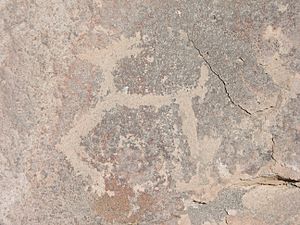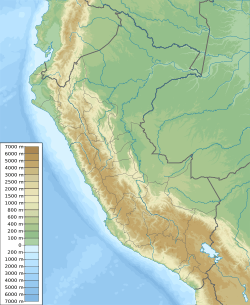Toro Muerto facts for kids

Petroglyph of a llama
|
|
| Location | Castilla Province, Arequipa Region, Peru |
|---|---|
| Coordinates | 16°13′20″S 72°30′28″W / 16.22222°S 72.50778°W |
| History | |
| Founded | Approximately 900 |
| Cultures | Wari culture |
Toro Muerto means "Dead Bull" in English. It is a huge collection of ancient rock carvings called petroglyphs. You can find them in the desert along the coast of Peru.
This amazing site is located in the Castilla area, within the Arequipa region of Peru. Toro Muerto has about 3,000 volcanic rocks. Each rock has carvings that were made by the Wari culture. The Wari people were active from about 500 to 1000 CE. They were an important civilization in the central Andes and coastal parts of modern-day Peru.
What are Petroglyphs?
Petroglyphs are images carved into rock. People made them by removing part of the rock surface. They often used a sharp stone to peck, cut, or rub away the outer layer.
These ancient artworks are like messages from the past. They can tell us about the lives, beliefs, and stories of the people who made them. Petroglyphs are found all over the world.
Toro Muerto: A Giant Rock Art Gallery
Toro Muerto is one of the largest collections of petroglyphs in the world. Imagine thousands of rocks, each with unique drawings! The rocks at Toro Muerto are volcanic. This means they came from volcanoes.
The carvings show many different things. You can see animals like llamas, birds, and snakes. There are also human-like figures and strange geometric shapes. Some carvings might show daily life or important events. Others could be symbols related to their religion.
The dry desert climate helped preserve these carvings for over a thousand years. It's like an open-air museum created by ancient artists.
The Wari People
The Wari were a powerful civilization in ancient Peru. They lived long before the famous Inca Empire. Their culture thrived between 500 and 1000 CE.
The Wari built large cities and a network of roads. They were skilled artists, especially known for their textiles (woven fabrics) and pottery. They also had a strong influence on other cultures in the region.
It is believed that the Wari people created the petroglyphs at Toro Muerto. They might have used the site for ceremonies or to mark important places. The carvings give us clues about their way of life and how they saw the world.
See also
 In Spanish: Petroglifos de Toro Muerto para niños
In Spanish: Petroglifos de Toro Muerto para niños


